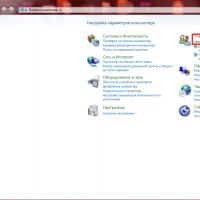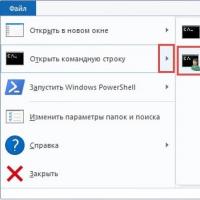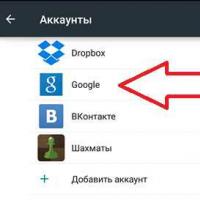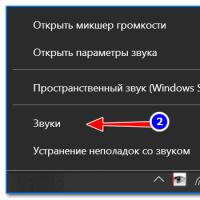Stargazing applications. Star Chart - constellations and planets
I do not presume to count the number of so-called astronomical programs, but I can say with confidence that they are all divided into two large groups. The first consists of lightweight applications designed mostly for entertainment; the second consists of powerful simulators used to educate aspiring astronomers.
The lion's share of programs for space exploration are written under Windows. And what about Android, is this operating system just as popular?
Are there astronomical programs for Android, and if so, how good are they? Of course there is, you just need to know where to look for them. As for the quality, in it they are in no way inferior to the Windows ones.
Star walk

At first I wanted to leave this application "for a snack", but then I decided that the first program in terms of quality of execution should be the first on the list.
Star Walk is perhaps the best application for the amateur study of the starry sky. This wonderful astronomical guide will allow you to navigate among the myriad of stars in real time. All you need is just to point your smartphone or tablet at the sky and all celestial bodies will be immediately identified. It doesn't matter if it is day or night.


The most significant space objects in Star Walk have a complete dossier. Also using this application you can learn information about constellations, nebulae, moon phases, trajectories of celestial bodies, etc. Also, you will be offered naturalistic pictures of planets, an astronomical calendar, various visual and audio effects. Star Walk is distributed on a paid basis, the cost of the application is low and is only $ 3.17.
Star Chart



Star Chart otherwise Star Chart can be considered as a very good alternative to Star Walk. It works in about the same way - point the device at the sky and you get a picture with a description of celestial bodies. The application provides detailed data on planets, stars, comets, constellations, solar systems and artificial satellites. Star Chart supports 3D mode, using audio commands, scaling, switching the color spectrum. Space photos used in the program are of excellent quality.
Sky map


The name of the third astronomical program on our list speaks for itself. Sky Map or Map of the Starry Sky is a simple free, open source application for viewing and studying the constellations of the starry sky. The application is developed by Google. The graphics are of no particular quality, but everything is free. Among the shortcomings, one can also note minor errors in the identification of celestial bodies.
Solar Walk features include viewing the interior of planets, visually exploring the Milky Way galaxy, tracking natural and artificial satellites in real time, exploring the history of space in a time machine, and much more.
The software has 3D support, but you need Cyan-Red 3D glasses to take advantage of it. Solar Walk is commercial. The app is inexpensive at just $ 2.90.
Need to download music from VK?

The colorful Star Chart program for android will help everyone who wants to study the stars in our Galaxy in detail. The application will introduce you to the planets and their satellites in the solar system. The user will see all the beauty of the starry sky anywhere in the world. This program can be considered educational. The user can know at any time what is the color, temperature, volume of each star. He will be able to study galaxies and their structure. The application database contains more than eighty constellations, more than one hundred thousand stars, more than one hundred amazing objects (clusters of stars, nebula, galaxies). Star Chart for Android has unique graphics. Satellites and planets in the program are presented in three-dimensional projection. The background of the constellations is decorated with artwork by the famous astronomer Hevelius. The trembling of the smartphone screen under the pulsation of the rays conveys the full magnitude of the sun. If you select any object, then full information will be displayed about its diameter, about the distance to the Sun and the Earth, about the period of rotation, the force of gravity, and temperature. Star Chart software is available in the free version. Additionally, for a fee, you can install satellites, meteorites, miniature planets in the gadget. If you constantly use the application, then over time you can remember the names of the stars and their location.


If you have long dreamed of unraveling star drawings, then this Star Chart will help you with this. The utility will reveal the secret where the sun hides at night and the stars are placed during the day. You can set coordinates manually, get a map and watch the sky on a foreign continent. And if you direct the smartphone down, under your feet, you can see the constellations that are located on the other side of the globe. Star Chart for android easily determines the location of a person relative to different constellations. The program provides a unique opportunity to study the starry sky through the camera of an android device. In this case, you can automatically calculate the position of all stars. An amazing picture of the world will open before the owner of the smartphone. And even during the day, you can admire the constellations and stars. To do this, you just need to point the smartphone camera at the sky. Star Chart for Android allows you to view the sky map both in real time and with displacement. You will be the first to know about the passage of a comet or meteor shower if you configure the program to receive notifications.
Want to visit the planetarium at home? The astronomical program provides you with this opportunity, and for free. Enter your coordinates and you will see the starry sky on the monitor screen as you see it with the naked eye or through a telescope. Virtual three-dimensional sky offered for review by the program includes more than 600,000 stars with the possibility of using additional catalogs containing more than 210,000,000 stars! Constellations, their names and images, planets with satellites, galaxies, nebulae, sunsets and sunrises can all be seen in scale with time control and with superbly detailed graphics thanks to the Stellarium virtual planetarium. Living in a city or without such necessary equipment as a telescope, it is difficult to study the starry sky. Now for studying astronomy there is virtual observatory
Star map and virtual planetarium
 |
Stellarium's virtual planetarium reflects a realistic view of the sky in real time. The program has a large database of the firmament, many settings and supports plugins. You can observe all the stars from the Hipparcos catalog, the solar system with satellites, the orbits of the planets, all the astronomical objects from the Messier and NGC catalog. Photos of galaxies, comets, mythical constellations with lines and names, large asteroids - you will find all this in the Stellarium desktop planetarium. The program can work in full screen mode and in a separate window. Detailed star map Stellarium is available for study without a telescope and spyglass, no need to travel out of town.
 |
Greetings readers Droider! As usual, at the beginning of the working week, we present the digest of applications for the operating system Android.
Since the current week (from 4th to 10th October) is “ World Space Week", Then we decided to devote a Big Review to applications that will allow owners of Android devices to get to know the stars and other celestial bodies better.
By the way, last Saturday 57 years ago, the first artificial satellite, PS-1, entered the orbit of our planet. It was a small ball weighing just over 80 kilograms and was equipped with signal transmitters that operated on batteries.
But back to our digest. In today's issue you will find: SkySafari, Vortex Planetarium, Solar Walk, Star Chart and.
We decided to start with one of the best astronomical encyclopedias for mobile devices. It's worth noting that we chose the most affordable version, which costs around $ 3. But in Google play you can find more advanced options that involve a colossal amount of data. The most expensive version will cost astronomy lovers $ 40.



If we talk about the application itself, then it has been around for a long time. And during all this time, the developers are actively developing and supplementing the base. The most "chip" version of SkySafari, at the moment, is endowed with information on 46,000 stars, 220 of the most famous star clusters, nebulae and galaxies. For comparison, SkySafari 4 Pro offers to learn about 25 million stars, 740 thousand galaxies and 630 000 objects.
The application also contains over a thousand encyclopedic descriptions of constellations, stars and planets, written by professional astronomers, and several hundred images obtained thanks to NASA and the Hubble Space Telescope.
Application from developers from the studio MagicTorch Software under the name it is a mobile "planetarium", with the help of which the owners of Android-devices will be able to see where certain constellations are located in the sky.

The main feature is that the application allows you to look at the starry sky even while sitting on the couch in your apartment. The creators added a special augmented reality technology to Vortex Planetarium, which works in tandem with the camera of a mobile device. To see the stars, you just need to run the utility and point the gadget's camera at the sky. This functionality alone sets Vortex Planetarium apart from other mobile planetariums.

As for the database of available celestial bodies, the application contains about 20,000 different objects. Among them are the planets and satellites of the solar system, various constellations, stars and meteor showers. For more convenient navigation in the variety, the developers have added a search function.
The app called is a 3D model of our solar system. With its help, the owners of smartphones and tablets on the Green Robot will be able not only to learn a lot of interesting things about objects located at a relatively small (by cosmic standards) distance from the Earth, but also to see their three-dimensional image.

In more detail, Solar Walk has various entertaining facts about any planets and moons. Moreover, this information is presented in both text and video formats. Of the interesting features of the application, one can single out the opportunity to consider the structure of an object in a section or to observe the trajectory of motion of some astronomical bodies (mostly artificial) in real time.

Also worth mentioning is the 3D mode. In case users have suitable 3D glasses (left glass - red, right - blue), then they can activate the volumetric mode and view space objects from a new side.
Solar Walk Free Solar Walk
StarChart- is perfect for those who are interested in the starry sky, but not good at astronomy. The application works on the principle of augmented reality - it is enough to "aim" the camera of the mobile device at the starry sky and you can start working.

Star Chart evaluates the current location and direction of the user's gaze using internal sensors and GPS. For the program to work, it is not at all necessary to have a perfectly clear starry sky - you can enjoy it in almost any setting.

With the help of the utility, users can not only look at the stars, but also get different information about them. Separately, we note that the Star Chart has additional content (satellites and meteor showers), to access which you will need to pay.
An app called AstronomyPictureoftheDay or APOD will be especially interesting for those who are fond of the beauty of space. Specialists from NASA Every day they take the most beautiful pictures of the endless universe with a telescope Hubble and ISS equipment. It is to them that the application opens access.



The program does not have any special settings and capabilities. But every day, APOD provides Android owners with fresh, colorful images of space. These can be distant galaxies, stars, black holes, or our Earth. The frames are accompanied by a description of the object or phenomenon captured on them.
But that's not all that APOD can do. When a new snapshot appears, the application can automatically set it as the background image. Also, users can select a photo from the gallery and set it as wallpaper on their own.
Of course, it is very pleasant to review the application, which is developed by a Russian company. And if you consider that the application has received a number of prestigious awards, it is doubly pleasant. As part of the project, we will talk about the Star Walk pocket observatory. If you are reading this blog, you will notice that Sasha is already, but that was half a year ago, since that moment there have been many changes, the most important of which is the version for Android.
Briefly
With Star Walk you can see stars, planets, constellations, satellites, meteor showers not only from the point where you are at the moment, but also from any place on Earth.
Requirements
iOS: 5.0 or later, 83 MB available space. Suitable for: iPhone, iPad and iPod touch. Application in Russian. Age 4+
Android 4.0 or later, 112 MB available space.
In detail
First of all, the application is interesting for those who like to look at the starry sky, but do not always understand what and where it is. Personally, I belong to this type of people. The principle of operation is that using GPS and an accelerometer, Star Walk determines the exact location of the device, and correlates what you see with a map of the starry sky. After launching, I found the moon in the sky, the application showed exactly the same location on my smartphone. Accordingly, when you move the device, the sky on it will also change. Perhaps this is the most important thing for me. The fact is that not all applications before that determined my coordinates correctly. You can click on each of the objects and then a page will drop out where you can read a detailed description of the object.
Star Walk has a lot of settings and filters. You can find a specific celestial body.
View sunrise and sunset times.
But personally, I am always interested in the ISS. It is always interesting to understand and observe the flight of the station, apparently this is due to the fact that people constantly live at the station. If you look at the sky and see a satellite, you can always understand whose it is.
Here is a short video that shows all the beauty.
____________________
Are you a developer? There is a special for you
 How to send on a megaphone waiting for a call
How to send on a megaphone waiting for a call Setting a password on a computer How to set a code on a computer at startup
Setting a password on a computer How to set a code on a computer at startup What is ESD format Open install esd
What is ESD format Open install esd How to format a mobile phone
How to format a mobile phone Information satellite systems named after academician M
Information satellite systems named after academician M Independent rating of the best Russian blogs LiveJournal blogs in Russian top 50
Independent rating of the best Russian blogs LiveJournal blogs in Russian top 50 How to set up a microphone on a laptop
How to set up a microphone on a laptop